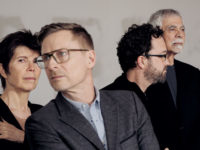As a partner at Ennead, the Manhattan architecture firm, Tomas Rossant has helped many colleges and universities develop master plans. He generally begins by spending a day observing people moving around campus, but what he finds, he admits, is “situational and subjective; it’s affected by whether it’s raining and whether it’s homecoming weekend, and so on.” So Ennead’s applied-computing department has developed an app to track where students and faculty go and when—potentially a better way to document campus activity. Rossant can’t talk about the details yet, but he has met with venture capitalists about turning the app into a product that could be made available to users other than Ennead and its clients.
“Do we want to give this away, or do we want to make money off it?” Rossant asks, suggesting that Ennead may take an “if-you-can’t-beat-’em-join-’em” attitude to software development, which could be more lucrative than just practicing architecture. If so, Ennead will probably create a discrete corporation to develop and sell its campus-planning software. In choosing that route, it would be following a trail blazed by Philadelphia-based KieranTimberlake (which offers several apps through its KT Innovations affiliate, owned by the firm’s founding partners) and the Seattle-headquartered NBBJ (which formed a separate company to market a virtual-reality tool)—and, much earlier, by Frank Gehry (whose firm spun off Gehry Technologies with its Digital Project software, in 2002).
Of course, not every architecture firm in the future will spawn a separate software company, but every architecture firm will have to respond to technological changes that are rocking the profession. Over the past two decades, new tools have transformed ateliers into veritable computer labs. But soon the continuing digital revolution may have even more dramatic consequences. “There are hundreds of kinds of technology that will impact the practice of architecture,” says Christian Derix, the director of Superspace, the computational-design group of Woods Bagot, a global firm with nearly 1,000 employees in 14 offices. “Architecture is facing an existential crisis,” agrees his colleague Shane Burger, a principal and director of technical innovation. He believes architecture firms that also do software will eventually turn into software firms that also do architecture. “I don’t see it as a threat to the profession,” says Burger. “I see it as a threat to the business model. It’s just a question of what the identity of the architecture firm will be 10 years from now.”
Other fields, from education to communications, have been radically altered by technology. “Architecture is ripe for disruption,” says Steve McConnell, the managing partner of NBBJ. “Efficiencies aren’t going to just be born out of a traditional architecture practice, but through application of high-tech tools.” Instead of expecting clients to rely solely on our expertise, he says, “now we have the ability to use algorithms to prove the value of our work.”
One technology that could be particularly disruptive to the profession is machine learning. An approach to achieving artificial intelligence, machine learning is a way for computers to discern patterns in vast quantities of data. But several experts say it could also be used to generate designs. According to Kat Park, the firm-wide emerging-technology leader for Skidmore, Owings & Merrill (SOM), machine learning is different from parametric modeling, in which you “wrote a script to produce a design outcome. That’s the old school way of using computers.” With machine learning, however, “there is no script. The computer is a black box.”
Is that one way that machines will replace human architects? Derix says that a computer with enough data on existing buildings—say, hospitals—can use algorithms to create configurations for a new one. “That’s where machine learning becomes dangerous to the profession,” he says. “Design will be a kind of data search.” But that prospect also offers promise, says Park. “If we took all of our firm’s past data and fed them into a machine, that would encode the expertise of SOM.”
A self-described optimist, Park says that machine learning may solve problems humans don’t have the brain power to solve—and do so almost instantaneously. That means that architects can get answers to complex questions early on. “We’ve been talking for so long about making performance analysis available at the concept stage, when it has the most impact,” she says, “but until now we haven’t had the tools.”
Woods Bagot’s Burger says the future will belong to architects “who are so used to working with these new tools that they become extensions of their minds.” He calls them “augmented” architects. Architects shouldn’t be scared of the new tools—a pencil is a tool, he notes. But, he says, “the firms that are going to survive are the ones that embrace the role of the augmented designer.” SOM’s Park concurs: “If you don’t know how to work with a robot, or work with an intelligent machine, you will probably be out of work.” (No wonder the new machines are sometimes known as “cobots.”)
For the architecture profession, there are other big challenges on the horizon. In recent years, firms like SHoP have pushed for modular construction, investing in technologies that would facilitate factory fabrication, providing greater control over the finished product. But now Silicon Valley tech companies are jumping into the game. Katerra, a startup with nearly $1 billion in funding from SoftBank, the Japanese conglomerate, is promising to use technology to transform design, the building-product supply chain, and the construction process. Architects have long chided the building industry for old-school ways, “but now it may leapfrog over us,” Rossant predicts. Yet SHoP continues to explore new construction and fabrication methods—most recently through a potential collaboration with a car company, according to partner Chris Sharples, though he declined to provide details.
Another well-financed start-up moving into architects’ territory is WeWork. Best known for providing shared office space to young creatives, the company is now selling design services to its corporate clients and is expanding beyond workplaces. It already employs architects in major cities. Last month, it appointed the Danish wunderkind Bjarke Ingels as its chief architect, upping its design game overnight.
So if architecture’s core functions are losing value, what does the profession have to offer? “Critical design thinking is the one thing that can’t be replaced by an algorithm,” says Rossant. “Right now, Ennead is an architecture firm that gives away strategy free. We’re thinking of becoming more of a strategy firm that gives away architecture free.” Though he makes clear that Ennead will always put architecture first, he would like the firm to compete with McKinsey & Company, the consulting group that charges handsomely to give business advice.
Nader Tehrani, dean of the architecture school at Cooper Union and founder of the Boston-based firm NADAAA, sees another way for architects to expand their role: “The architectural voice can become instrumental in the many political and cultural conversations that are affecting the world today, among them climate change, health, education, food, and the state of the city as a place to live, to name just a few.” Kennedy Violich Architects, based in Boston, has been bringing “design thinking” to non-architectural problems since its early days. It worked with a startup company that uses big data to reduce solar-energy costs through peer-to-peer energy sharing in Australia. More recently, in the Peruvian Andes, the firm led a workshop that helped devise a system for Wi-Fi connectivity in high-altitude villages. The goal, says principal Sheila Kennedy, is to “imagine the future while testing ideas on the ground in the present reality.”
One way for firms to embrace the future is to rely on expertise from other fields. NBBJ offers a fellowship, which for the last four years has been held by a neuroscientist, John Medina, who works with the firm’s architects to identify ways buildings can improve health and happiness. Methods include encouraging movement, bringing users into contact with nature, and facilitating serendipitous meetings among colleagues. The office translated Medina’s insights into computer simulations, to predict the number of such interactions likely to occur in each iteration of an office tower designed for the Chinese company Tencent, in Shenzhen.
KieranTimberlake, meanwhile, hired architects who also have degrees in fields like sociology, ecology, and computer science. “When I joined the firm in 2008,” says Billie Faircloth, a partner and the company’s tech guru, “my charge was to build up a transdisciplinary practice.” While assigned to actual design projects, KieranTimberlake’s architect hyphenates also form internal research groups. On a recent Friday, the dozen or so members of a group called Near Future Practices met in a conference room in the firm’s Philadelphia office, a former beer-bottling factory, to discuss using machine learning as a way of improving buildings’ energy efficiency. “If we had the data on predicted versus actual energy consumption of a large number of buildings, we could begin to rank which factors actually matter in terms of energy use,” she says. But the amount of data required is, Faircloth cautions, “bigger than any one firm. So we have to ask ourselves, as a profession, do we want to work together to get this data? And,” given privacy concerns, “is it appropriate to do so?” These are the kind of questions that architects’ moving rapidly into evolving technologies, and their clients, will have to address.
Meanwhile, NBBJ has taken another route to getting out in front of technological change. Seeing an opportunity not just to improve practice and engage clients but to create another income stream, NBBJ founded the virtual-reality (VR) firm Visual Vocal, staffed it with non-architects, and funded it with more than $3.5 million in venture capital. Its product, developed after studying how architects at NBBJ collaborate, is a communications tool that allows project stakeholders to annotate VR presentations verbally. Visual Vocal is selling the product to other firms. But that doesn’t trouble McConnell, who is pleased with the cross fertilization. “We’re putting a start-up and a mature business together” in the same office, says McConnell. “That’s how you avoid becoming calcified.”
KieranTimberlake has also created potentially profit-making products apart from its core architectural practice. On Faircloth’s watch, KT Innovations has released Tally (life-cycle assessment software), Pointelist (a low-cost, high-density sensor network), and, most recently, Roast (an occupant-comfort survey app now in beta testing).
In Toronto in May, at the Smartgeometry conference, a biannual gathering of architecture brainiacs, Faircloth and Christopher Connock, KieranTimberlake’s director of design computation, shared insights with representatives of other research-oriented firms, including Woods Bagot and SOM. Although many of the participants are competitors, “we are all interested in the positive redefinition of what an architect does,” says Burger. Naturally, he says, “I’m not handing out code for software that we’ve developed in our practice. But we’re all here to help each other. We all think it’s beneficial to the world to have a healthy architecture profession.”












Post a comment to this article
Report Abusive Comment